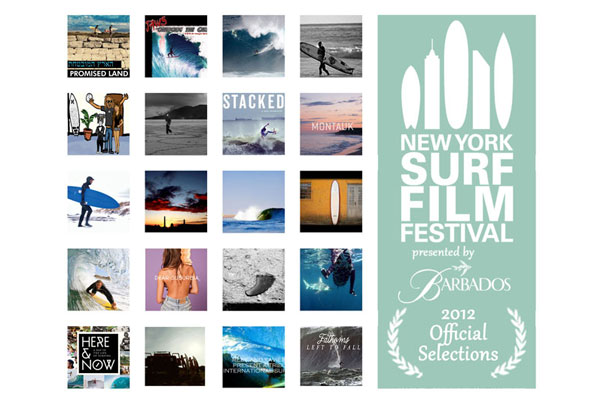 The fifth annual New York Surf Film Festival starts next week at Nitehawk in Williamsburg. Check out this year’s lineup and get your tickets while you can.
The fifth annual New York Surf Film Festival starts next week at Nitehawk in Williamsburg. Check out this year’s lineup and get your tickets while you can.
Blog
NYC Surf Film Festival
Earthquake News from Voz de Nosara
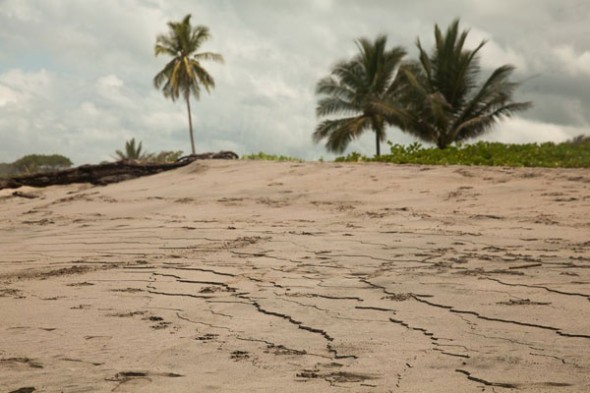
Ripples lay across the sand following the 7.6 scale earthquake which struck Costa Rica's pacific coast the morning of September 5th, 2012.
We’re grateful to the Voz de Nosara for updates about last week’s earthquake. More news from the Costa Rican Red Cross here.
The Very Bad Wizards Podcast
One of our goals for the Philosophy in Residence program was to finally launch the podcast series that we had been developing this past year. From the beginning, Dave and I loved the idea of presenting accessible and (hopefully) entertaining discussions about the central issues in science and ethics. But we had a problem: neither of us had a clue how to record, edit, upload, and promote a real podcast. Even worse, Dave lives in Ithaca, NY and I’m in Houston. This meant having to record the conversations long distance, a technical nightmare as it turns out.
Our time at the Harmony Hotel proved to be exactly what we needed. Before the residency we had only been able to successfully record one episode. In Nosara we were able to record several in one week, and the generosity of the hotel gave us more than enough motivation to do all the grunt work involved in launching the project. And so, after over a year of development and false starts, and one week in Philosophers in Residence program, our first two episodes are now available in the iTunes store and at our website. We hope you subscribe and enjoy them! (more…)
30 Variations and a Microphone
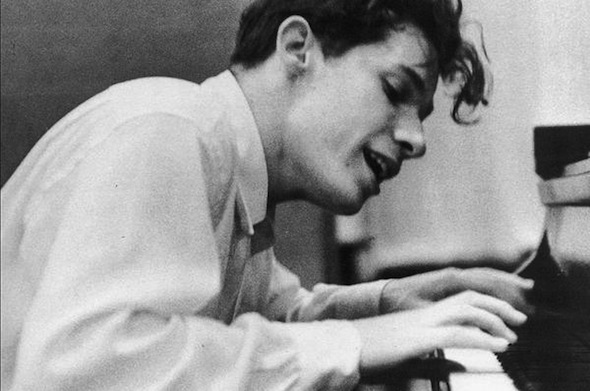 Glenn Gould has little to do with surf culture; even when it was warm, he wore “an overcoat, a beret, a scarf and gloves.” Nonetheless, the publication of an essay about Gould’s 1955 recording of Bach’s Goldberg Variations merits your attention, not least because its author is Paul Elie, who published a wonderful prosopography of American Catholic activists titled The Life You Save May Be Your Own. (Great title, great book.) This weekend’s New York Times Magazine includes an excerpt from his new book Reinventing Bach, which will be published in the United States on September 18. A little taste:
Glenn Gould has little to do with surf culture; even when it was warm, he wore “an overcoat, a beret, a scarf and gloves.” Nonetheless, the publication of an essay about Gould’s 1955 recording of Bach’s Goldberg Variations merits your attention, not least because its author is Paul Elie, who published a wonderful prosopography of American Catholic activists titled The Life You Save May Be Your Own. (Great title, great book.) This weekend’s New York Times Magazine includes an excerpt from his new book Reinventing Bach, which will be published in the United States on September 18. A little taste:
The “Goldberg” Variations is a piece of architecture. Gould is climbing over Bach’s construction, clambering over the whole.
Gould used the studio, first of all, to give full expression to the variety of the parts. By recording the variations one at a time, in multiple takes, he set them apart from one another, exaggerating their individuality. Each of them can be considered with wonder. But something is lost when the variations are taken apart — sold separately, as it were. Gould recognized this as well, and even as he used technology to isolate the parts, he used his technique as a pianist to make them whole.
There is no piece of music whose history is so divided into “before” and “after” by one performer as the history of the “Goldberg” Variations is divided into before and after by Glenn Gould. And few artists have been so good at presenting a self-image and making it central to their art. But Gould went further: he imprinted his image of himself onto Bach. This is a good measure of Gould’s achievement — that he made an unlikeness seem a likeness.
To read the rest of this essay, click here. And, by all means, if you haven’t heard Gould’s two recordings of The Goldberg Variations—the second was released in 1981—I urge you to do so. Here’s an Amazon link; here’s an iTunes link. Back to our regularly scheduled programming tomorrow.
Eleanor Antin, 100 Boots Facing the Sea
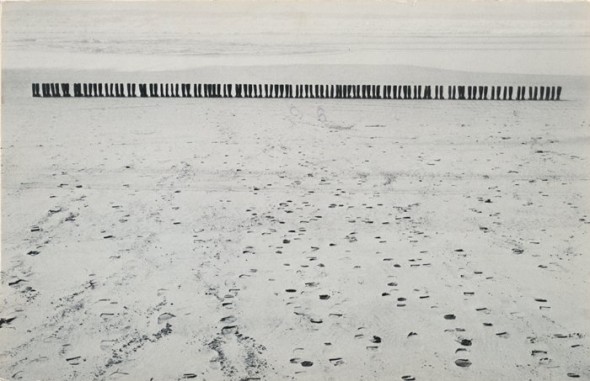
Eleanor Antin, 100 Boots Facing the Sea, 1971, from the series 100 Boots, a set of 51 photo-postcards, 1971; photograph; halftone photo-postcard, Collection SFMOMA
MS. ANTIN: But I was tired of traveling into New York to show. I thought I’ve got to do a piece that can get around the world without me, so I can stay here. I loved old San Diego before the McMansions came in. I lived over the ocean. I didn’t even drive in those early days. I hitched. You could hitch in those days. It was before Charles Manson. It was a different world.
Solana Beach and Del Mar, they were little beach towns. Del Mar had a certain cache because movie stars used to go there. Mary Pickford’s little pink cottage is still there across from the post office. Solana Beach was just a little sleepy town of kid surfers and older people who were retired.
Enter 100 Boots. My new hero.
I bought 50 pairs of boots, big men’s boots, in the Army-Navy surplus. I think they cost $200 in those days for all of them. Now they would cost a fortune. It was six cents for a postage stamp, for a first class postcard. In the middle of the piece, it became eight cents. I didn’t like that. I was indignant.
But I put together a mailing list. When I had a pretty big one, I started mailing out my 100 Boots and I didn’t have to leave town. All I had to do was shoot them and print them up as postcards. Suddenly they hit all over the place. They were written about all over the country. Like The Washington Post did this interesting thing. They’d print a different Boot image on each page. The caption would suggest the reader go on to see the next image on another page. Then the next one and the next one. Then people would write to the paper ask if Eleanor Antin would put them on her mailing list. The paper forwarded the letters to me and I’d add the names to my mailing list.
Some people would say, stop harassing me, go away, I hate you, take me off your mailing list. Some people, when they’d move would let me know their new mailbox, their new address. I would make the changes in my mailing list. Other people wouldn’t and when their cards were returned, they were removed. The piece went on for two-and-a-half years. It hit so big.
The New Yorker on Mud Wrestling in the Rockaways
Move over New York Times, now the New Yorker seems to have a beat reporter in the Rockaways. Have a look at this article by Mary Norris on mud wrestling at the Rockaway Beach Surf Club. An excerpt:
The Rockaway Beach Surf Club is on the premises of a former chop shop at Beach Eighty-seventh Street, under the El, just where the tracks curve north to the trestle bridge over Jamaica Bay. You’ll know it by the two big blue disco balls on the roof, visible from the train. Pay no attention to the block of self-storage units on the other side of the tracks. Concentrate on the fake palm tree in the neighboring yard.
The Onjuku Surf Shack
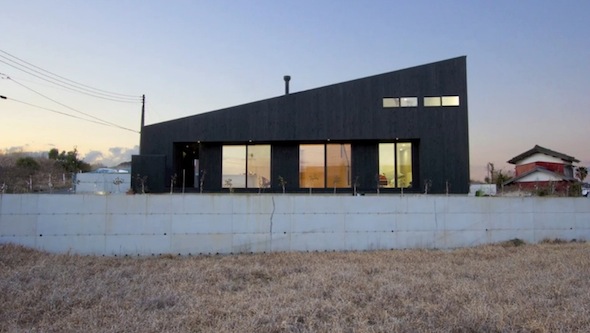 Designed by Japanese firm Bakoko, the Onjuku Surf Shack was built for an international couple who loves to surf. It can be opened to the ocean breezes and is located in a coastal fishing village approximately ninety minutes from Tokyo. Click through to The Fox Is Black to watch a two-minute video demonstrating the house’s features.
Designed by Japanese firm Bakoko, the Onjuku Surf Shack was built for an international couple who loves to surf. It can be opened to the ocean breezes and is located in a coastal fishing village approximately ninety minutes from Tokyo. Click through to The Fox Is Black to watch a two-minute video demonstrating the house’s features.
Koji Enokura, Symptom-Sea-Body (P.W.-No. 40)
A favorite work from “Requiem for the Sun: The Art of Mono-ha.” The exhibition, which began at Blum and Poe in Los Angeles and traveled to Gladstone Gallery in New York, examined the postwar Japanese artistic phenomenon Mono-ha (School of Things). According to a press release “Requiem for the Sun” refers to “the attitude of aesthetic detachment and renewal of matter in response to the immanent loss of the object as a sun in Japanese postwar art practice.” Included in the show were works by Koji Enokura (1942-1995), Noriyuki Haraguchi (1946- ), Susumu Koshimizu (1944- ), Katsuhiko Narita (1944-1991), Nobuo Sekine (1942- ), Kishio Suga (1944- ), Jiro Takamatsu (1936-1998), Noboru Takayama (1944- ), Lee Ufan (1936- ), and Katsuro Yoshida (1943-1999).
More images from the LA iteration here.






